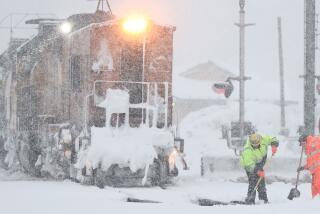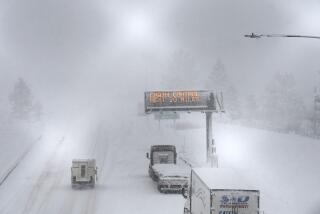5-Foot Drifts Isolate 4,500; Food, Fuel Low
- Share via
A persistent Arctic storm continued to harass Southern California on Thursday, dumping heavy snow that drifted up to 5 feet deep across Interstate 5 in the mountains north of Los Angeles and isolating about 4,500 people in four small communities.
Some of the residents and motorists stranded by the snow since Tuesday in Frazier Park, Gorman, Holiday Valley and Lebec were beginning to run out of food and propane late Thursday night.
Caltrans officials said that, although some emergency vehicles were able to get through late Thursday, Interstate 5, the main north-south artery in the state, probably would remain closed until sometime this morning.
For Dawn Yates, who lives with her husband, David, and their two sons, Kenneth, 2, and Kyle, 9 months, in a home about 10 miles off the freeway, the wait will probably be even longer. Priority is being given to the interstate; local roads leading to many of the scattered residents will come later, officials said.
‘Getting Low on Food’
“It’s getting scary,” Yates said in a telephone interview from her rural home in the Holiday Valley area. “We’re getting low on food, especially baby food. . . .
“We’ve got some stuff in the freezer, and we’re stretching things,” she said. “The baby food and the formula probably won’t last past Friday. . . . We’re out of dog food. But he’s learning to eat potatoes.”
Yates said propane used for cooking and heating was beginning to get low, “but it’ll probably last until Sunday or Monday, if we’re careful.”
One other thing was bothering Yates.
“We’d been planning to go to Las Vegas this weekend to celebrate our third (wedding) anniversary,” she said. “I guess we won’t make it.”
Dino Mastrocinque, who owns Mark’s coffee shop in the Gorman area, said Thursday that about 15 motorists--most of them truck drivers--had been staying at his cafe since the freeway closed Tuesday night.
“They spend the time playing in the snow, playing poker and blackjack and sleeping in the booths,” he said. “Some of the drivers are cranky because they’re losing money; some are happy because they get paid by the hour. . . .
“The coffee will last for another day, and so will the hamburgers,” Mastrocinque said. “This isn’t a bad place to stay, and (the rent is) free.”
Another dozen people spent Wednesday and Thursday nights sleeping in dining booths in the Gorman Plaza Coffee Shop.
Some Sleep on Couches in Lobby
Across the street at the Caravan Inn, motorists and truck drivers doubled up after the motel’s 60 rooms were all taken. Several other stranded travelers slept on couches in the lobby.
Caltrans spokesman Thomas Knox said 17 snow-plow trucks, three graders and a rotary snow plow were working “pretty much around the clock” to clear the 50-mile stretch of Interstate 5 closed between Lake Hughes Road on the south and Laval Road on the north.
The California Highway Patrol said about 50 big trucks were stranded along the route, commonly known as the “Grapevine,” but all the drivers apparently had made it safely to shelter in cafes, gas stations and homes.
A tow truck driver said between 300 and 400 vehicles had been pulled from snow drifts from Pyramid Lake to Lebec since Wednesday morning.
“There are high winds and a great deal of drifting snow,” Knox said. “That’s making it very difficult to clear.”
Northbound drivers were advised to use the coastal route, U.S. 101, as an alternative.
Trucker Mark Jacks, 33, of Vallejo, was stranded in Gorman as he headed for Oakland with a load of 4-wheel drive vehicles. A sheriff’s deputy advised him that he could cut across to the coastal route, but a wary Jacks declined.
“The last time I tried that, I was stopped on 101 by an avalanche,” he said.
Montgomery, Ala., house painter Tony Dennis, 36, and his friend Barbara Sikes, 48, were stranded in Gorman en route back home after visiting relatives in Sacramento.
“I never knew it snowed in California,” Dennis said. “I never expected anything like this.”
The Caltrans crews will next attack California 138, which is closed west from Interstate 5 past Frazier Park, and east past Holiday Valley. After that, plows will beginning local roads, like the dirt one that leads 3 miles from California 138 to the Yates home.
In the meantime, area residents such as the Yateses and Kay Williamson will just keep hoping that the food and propane hold out and no one gets seriously ill.
“I guess if someone gets sick we’ll call 911 and just hope the helicopter can get in here,” Williamson said.
Other major thoroughfares through the San Gabriel Mountains, closed for much or all of Wednesday, were reopened Thursday.
Snow continued to fall sporadically Thursday in the Antelope Valley, where as much as a foot accumulated and 35,000 students escaped classes for the second straight day because of the weather. Caltrans crews were able to scrape away enough of the falling snow to keep California 14 open between Newhall and Palmdale. But motorists were being escorted through by the CHP and delays of several hours were reported.
Chains Advised
Interstate 15 through Cajon Pass, the major route to Las Vegas, was open, but the CHP advised motorists to use chains there and on all other roads through the San Bernardino Mountains, where heavy snow fell in the resort areas.
The snow that had fallen in the foothill communities in and around Los Angeles on Wednesday was gone by Thursday morning, melted into a brown, unrecognizable slush.
A total of .81 of an inch of rain had fallen at the Los Angeles Civic Center by 3 p.m. Thursday, raising the season’s total to 7.16 inches. That total was exactly 2 inches below the normal seasonal total for the date.
The high temperature in downtown Los Angeles on Thursday was 53 degrees, following an overnight low of 45. Those readings compare strikingly with a year ago, when the Feb. 9 high was 85, following an overnight low of 52.
Dave Beusterien, a meteorologist with WeatherData Inc., which provides forecasts for The Times, said the snow and rain should end by this morning as the low-pressure systems that brought them edge slowly to the north.
High temperatures in the Los Angeles Basin should be in the upper 50s.
Saturday should be partly cloudy with highs near 60, Beusterien said. Cloudiness is expected to increase Sunday, with a slight chance of rain.
Despite generally moderating temperatures, the Southern California Gas Co. announced Thursday that it will broaden its cutoff of natural gas deliveries to commercial customers at 6 a.m. today to leave more fuel for residential consumers.
The new cutoffs will include about 850 large commercial and industrial users with backup fuel systems.
The gas company, blaming cold weather for shortages, had curtailed deliveries Tuesday to the electric utilities that normally burn gas to power their boilers. The utilities switched to oil, as most of the industrial customers are expected to do.
Frigid weather across the Southwest has driven demand for natural gas to record levels in Southern California, while causing freeze-ups and related problems in the Texas, Oklahoma and New Mexico gas fields where Southern California Gas gets most of its fuel. The resulting shortfall in daily shipments has forced the company to draw heavily from its underground reserves.
Water Rationing Seen
Despite rain showers in Northern California, which deposited more than half an inch Thursday, San Francisco officials announced a rationing plan that could call for a 35% cutback from normal water use this summer.
“The next 30 days days are really critical,” city spokesman Matt Mullan said, noting that the end of February marks the end of what should be the winter wet season. An additional 18 inches of rain this month would ease the crisis, but average rainfall for February is only 9 or 10 inches, he said.
Agricultural officials welcomed the rain, but indicated it would take more than one storm to end fears of a third straight drought year.
“It’s a start, especially after such a dry January,” said Robert Leake, manager of the Fresno Irrigation District. “But we’re going to need a lot more rain in the valley and snow in the Sierra over the next few weeks if we are to avoid another dry year.”
Times staff writers Charles Hillinger and Donald Woutat contributed to this article.
More to Read
Sign up for Essential California
The most important California stories and recommendations in your inbox every morning.
You may occasionally receive promotional content from the Los Angeles Times.













